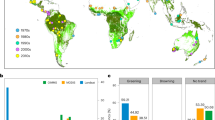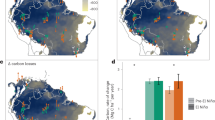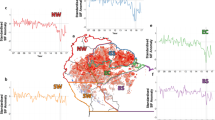Abstract
Tropical forests are global epicentres of biodiversity and important modulators of climate change1, and are mainly constrained by rainfall patterns1,2,3. The severe short-term droughts that occurred recently in Amazonia have drawn attention to the vulnerability of tropical forests to climatic disturbances4,5,6,7,8,9. The central African rainforests, the second-largest on Earth, have experienced a long-term drying trend10,11 whose impacts on vegetation dynamics remain mostly unknown because in situ observations are very limited. The Congolese forest, with its drier conditions and higher percentage of semi-evergreen trees12,13, may be more tolerant to short-term rainfall reduction than are wetter tropical forests11, but for a long-term drought there may be critical thresholds of water availability below which higher-biomass, closed-canopy forests transition to more open, lower-biomass forests1,2,14. Here we present observational evidence for a widespread decline in forest greenness over the past decade based on analyses of satellite data (optical, thermal, microwave and gravity) from several independent sensors over the Congo basin. This decline in vegetation greenness, particularly in the northern Congolese forest, is generally consistent with decreases in rainfall, terrestrial water storage, water content in aboveground woody and leaf biomass, and the canopy backscatter anomaly caused by changes in structure and moisture in upper forest layers. It is also consistent with increases in photosynthetically active radiation and land surface temperature. These multiple lines of evidence indicate that this large-scale vegetation browning, or loss of photosynthetic capacity, may be partially attributable to the long-term drying trend. Our results suggest that a continued gradual decline of photosynthetic capacity and moisture content driven by the persistent drying trend could alter the composition and structure of the Congolese forest to favour the spread of drought-tolerant species1,2,14.
This is a preview of subscription content, access via your institution
Access options
Subscribe to this journal
Receive 51 print issues and online access
$199.00 per year
only $3.90 per issue
Buy this article
- Purchase on Springer Link
- Instant access to full article PDF
Prices may be subject to local taxes which are calculated during checkout




Similar content being viewed by others
References
Lewis, S. L. Tropical forests and the changing earth system. Phil. Trans. R. Soc. Lond. B 361, 195–210 (2006)
Enquist, B. J. & Enquist, C. A. F. Long-term change within a neotropical forest: assessing differential functional and floristic responses to disturbance and drought. Glob. Change Biol. 17, 1408–1424 (2011)
Lewis, S. L. et al. Above-ground biomass and structure of 260 African tropical forests. Phil. Trans. R. Soc. Lond. B 368, 20120295 (2013)
Brando, P. M. et al. Seasonal and interannual variability of climate and vegetation indices across the Amazon. Proc. Natl Acad. Sci. USA 107, 14685–14690 (2010)
Xu, L. et al. Widespread decline in greenness of Amazonian vegetation due to the 2010 drought. Geophys. Res. Lett. 38, L07402 (2011)
Samanta, A., Ganguly, S., Vermote, E., Nemani, R. R. & Myneni, R. B. Why is remote sensing of Amazon forest greenness so challenging? Earth Interact. 16, 1–14 (2012)
Atkinson, P. M., Dash, J. & Jeganathan, C. Amazon vegetation greenness as measured by satellite sensors over the last decade. Geophys. Res. Lett. 38, L19105 (2011)
Saatchi, S. et al. Persistent effects of a severe drought on Amazonian forest canopy. Proc. Natl Acad. Sci. USA 110, 565–570 (2013)
Morton, D. C. et al. Amazon forests maintain consistent canopy structure and greenness during the dry season. Nature 506, 221–224 (2014)
Malhi, Y. & Wright, J. Spatial patterns and recent trends in the climate of tropical rainforest regions. Phil. Trans. R. Soc. Lond. B 359, 311–329 (2004)
Asefi-Najafabady, S. & Saatchi, S. Response of African humid tropical forests to recent rainfall anomalies. Phil. Trans. R Soc. B 368, 20120306 (2013)
Adams, J. The distribution and variety of equatorial rain forest. http://www.esd.ornl.gov/projects/qen/rainfo.html . (1998)
Ashton M. S., Tyrrell M. L., Spalding D., Gentry B., eds. Managing Forest Carbon in a Changing Climate (Springer, 2012)
Fauset, S. et al. Drought-induced shifts in the floristic and functional composition of tropical forests in Ghana. Ecol. Lett. 15, 1120–1129 (2012)
Huete, A. et al. Overview of the radiometric and biophysical performance of the MODIS vegetation indices. Remote Sens. Environ. 83, 195–213 (2002)
Myneni, R. B., Hall, F. G., Sellers, P. J. & Marshak, A. L. The meaning of spectral vegetation indices. IEEE Trans. Geosci. Remote Sens. 33, 481–486 (1995)
Huete, A. R. et al. Amazon rainforests green-up with sunlight in dry season. Geophys. Res. Lett. 33, L06405 (2006)
Nemani, R. R. et al. Climate-driven increases in global terrestrial net primary production from 1982 to 1999. Science 300, 1560–1563 (2003)
de Wasseige, C., Bastin, D. & Defourny, P. Seasonal variation of tropical forest LAI based on field measurements in Central African Republic. Agric. For. Meteorol. 119, 181–194 (2003)
Schneider, U. et al. GPCC’s new land surface precipitation climatology based on quality-controlled in situ data and its role in quantifying the global water cycle. Theor. Appl. Climatol. 115, 15–40 (2014)
Adler, R. F. et al. The Version 2 Global Precipitation Climatology Project (GPCP) monthly precipitation analysis (1979-present). J. Hydrometeorol. 4, 1147–1167 (2003)
Huffman, G. J. et al. The TRMM Multi-satellite Precipitation Analysis: quasi-global, multi-year, combined-sensor precipitation estimates at fine scale. J. Hydrometeorol. 8, 38–55 (2007)
Crowley, J. W., Mitrovica, J. X., Bailey, R. C., Tamisiea, M. E. & Davis, J. L. Land water storage within the Congo Basin inferred from GRACE satellite gravity data. Geophys. Res. Lett. 33, L19402 (2006)
Reager, J. T. & Famiglietti, J. S. Characteristic mega-basin water storage behavior using GRACE. Wat. Resour. Res. 49, (2013)
Liu, Y. Y., van Dijk, A. I. J. M., McCabe, M. F., Evans, J. P. & de Jeu, R. A. M. Global vegetation biomass change (1988–2008) and attribution to environmental and human drivers. Glob. Ecol. Biogeogr. 22, 692–705 (2013)
Andela, N., Liu, Y. Y., van Dijk, A. I. J. M., de Jeu, R. A. M. & McVicar, T. R. Global changes in dryland vegetation dynamics (1988–2008) assessed by satellite remote sensing: comparing a new passive microwave vegetation density record with reflective greenness data. Biogeosciences 10, 6657–6676 (2013)
Lucht, W., Schaphoff, S., Erbrecht, T., Heyder, U. & Cramer, W. Terrestrial vegetation redistribution and carbon balance under climate change. Carbon Balance Manag. 1, 6 (2006)
Lee, H. et al. Characterization of terrestrial water dynamics in the Congo Basin using GRACE and satellite radar altimetry. Remote Sens. Environ. 115, 3530–3538 (2011)
Valentini, R. et al. The full greenhouse gases budget of Africa: synthesis, uncertainties and vulnerabilities. Biogeosci. Discuss. 10, 8343–8413 (2013)
Nepstad, D. C., Tohver, I. M., Ray, D., Moutinho, P. & Cardinot, G. Mortality of large trees and lianas following experimental drought in an amazon forest. Ecology 88, 2259–2269 (2007)
Wan, Z. New refinements and validation of the MODIS land surface temperature/emissivity products. Remote Sens. Environ. 112, 59–74 (2008)
Friedl, M. A. et al. MODIS Collection 5 global land cover: algorithm refinements and characterization of new datasets. Remote Sens. Environ. 114, 168–182 (2010)
DiMiceli, C. M. et al. Annual Global Automated MODIS Vegetation Continuous Fields (MOD44B) at 250 m Spatial Resolution for Data Years Beginning Day 65, 2000-2010, Collection 5 Percent Tree Cover. (Univ. Maryland, 2011) ; http://www.landcover.org/data/vcf
King, M. D. et al. Cloud and aerosol properties, precipitable water and profiles of temperature and water vapor from MODIS. IEEE Trans. Geosci. Rem. Sens. 41, 442–458 (2003)
Remer, L. A. et al. MODIS aerosol algorithm, products and validation. J. Atmos. Sci. 62, 947–973 (2005)
Platnick, S. et al. The MODIS cloud products: algorithms and examples from Terra. IEEE Trans. Geosci. Rem. Sens. 41, 459–473 (2003)
Hansen, M. C. et al. A method for integrating MODIS and Landsat data for systematic monitoring of forest cover and change in the Congo Basin. Remote Sens. Environ. 112, 2495–2513 (2008)
van Leeuwen, T. T. et al. Optimal use of land surface temperature data to detect changes in tropical forest cover. J. Geophys. Res. 116, G02002 (2011)
Harris, I., Jones, P. D., Osborn, T. J. & Lister, D. H. Updated high-resolution grids of monthly climatic observations. Int. J. Climatol. 34, 623–642 (2013)
Landerer, F. W. & Swenson, S. C. Accuracy of scaled GRACE terrestrial water storage estimates. Water Resour. Res. 48, W04531 (2012)
Swenson, S. C. & Wahr, J. Post-processing removal of correlated errors in GRACE data. Geophys. Res. Lett. 33, L08402 (2006)
Wielicki, B. A. et al. Clouds and the Earth's Radiant Energy System (CERES): an Earth observing system experiment. Bull. Am. Meteorol. Soc. 77, 853–868 (1996)
Kirdyashev, K. P., Chukhlantsev, A. A. & Shutko, A. M. Microwave radiation of the Earth's surface in the presence of a vegetation cover. Radio Eng. Electron. Phys. 24, 37–44 (1979)
Kerr, Y. H. & Njoku, E. G. A semiempirical model for interpreting microwave emission from semiarid land surfaces as seen from space. IEEE Trans. Geosci. Remote Sens. 28, 384–393 (1990)
Jackson, T. J. & Schmugge, T. J. Vegetation effects on the microwave emission of soils. Remote Sens. Environ. 36, 203–212 (1991)
Shi, J. C. et al. Microwave vegetation indices for short vegetation covers from satellite passive microwave sensor AMSR-E. Remote Sens. Environ. 112, 4285–4300 (2008)
Jones, M. O., Jones, L. A., Kimball, J. S. & McDonald, K. C. Satellite passive microwave remote sensing for monitoring global land surface phenology. Remote Sens. Environ. 115, 1102–1114 (2011)
Liu, Y. Y., de Jeu, R. A. M., McCabe, M. F., Evans, J. P. & van Dijk, A. I. J. M. Global long-term passive microwave satellite-based retrievals of vegetation optical depth. Geophys. Res. Lett. 38, L18402 (2011)
Liu, Y. Y. et al. Developing an improved soil moisture dataset by blending passive and active microwave satellite-based retrievals. Hydrol. Earth Syst. Sci. 15, 425–436 (2011)
Liu, Y. Y. et al. Trend-preserving blending of passive and active microwave soil moisture retrievals. Remote Sens. Environ. 123, 280–297 (2012)
Halldor, B. & Venegas, S. A. A Manual for EOF and SVD Analyses of Climate Data. (Report No. 97-1, Centre for Climate and Global Change Research, McGill Univ., 1997)
Zhou, L., Tian, Y., Chen, H., Dai, Y. & Harris, R. A. Effects of topography on assessing wind farm impacts using MODIS data. Earth Interact. 17, 1–18 (2013)
Acknowledgements
This study was supported by the NOAA NESDIS project (NA11NES4400010) and by the startup funds provided by the University at Albany, State University of New York. R.B.M. was funded by NASA’s Earth Science Division. The views, opinions, and findings contained in this report are those of the authors and should not be construed as an official NOAA or US Government position, policy, or decision. H.C. is supported by the National Natural Science Foundation of China (grant number 41230422).
Author information
Authors and Affiliations
Contributions
L.Z. and Y.T. contributed the central idea, analysed most of the data, and wrote the initial draft of the paper. The remaining authors contributed to refining the ideas, carrying out additional analyses and finalizing this paper.
Corresponding author
Ethics declarations
Competing interests
The authors declare no competing financial interests.
Extended data figures and tables
Extended Data Figure 1 Statistics of MODIS data quality and MODIS high-quality EVI mask.
a–d, Seasonal statistics of the total number of high-quality MODIS EVI composites over forested pixels at 0.05° resolution in central tropical Africa (7° S–7° N, 5–31 °E) for the period 2000–2012. For each season, there are up to 39 EVI composites (three composites per year multiplied by 13 years) for every pixel. e, The climatology of MODIS percentage forest cover at 0.05° resolution. f, The high-quality MODIS April–May–June EVI mask at 0.25° resolution over the intact Congo forest (6° S–5° N, 14–31° E) used in the analysis (see details in Methods).
Extended Data Figure 2 Spatial patterns of linear trends in April–May–June TWS (cm per decade) and correlation coefficients R between TWS and EVI for the period 2003–2012.
a–c, As in Fig. 2e but for TWS from individual data processing centres (the University of Texas’ Center for Space Research (CSR), NASA’s Jet Propulsion Laboratory (JPL) and Germany’s GeoForschungsZentrum (GFZ)). d, The topography of the Congo basin (http://en.wikipedia.org/wiki/File:Congo_Kinshasa_Topography.png). e, f, R between April–May–June EVI and ensemble-mean TWS in April–May–June (AMJ) and January–February–March (JFM). The significance level of R (its P value) is estimated using a two-tailed Student’s t-test. Pixels with a plus symbol have a linear trend or an R that is statistically significant at P < 0.1. The percentages of pixels with trends or R at P < 0.05 and P < 0.1 and the percentages of pixels with negative trends or positive R over the study region are shown.
Extended Data Figure 5 Annual mean VOD anomalies (unitless; a) and linear trends per decade (b).
For the period 1988–2010 (as in Fig. 4).
Extended Data Figure 6 Spatial patterns of linear trends per decade in April–May–June for MODIS reflectance in the blue (BLU; a), red (RED; b) and near-infrared (NIR; c) spectral bands.
For the period 2000–2012 (as in Fig. 2a).
Extended Data Figure 8 Simulated surface reflectance values in the MODIS red (RED; a), near-infrared (NIR; b) and blue (BLU; c) bands using the 6S radiative transfer code for 25% overestimation or 25% underestimation of AOT.
There are 30 cases (cases 1–10 correspond to a small AOT load, AOT = 0.1; cases 11–20 correspond to a medium AOT load, AOT = 0.3; cases 21–30 correspond to a large AOT load, AOT = 0.5) and the actual reflectance is 0.03, 0.3 and 0.02 in RED, NIR and BLU, respectively (see details in Supplementary Table 1).
Extended Data Figure 9 Regional mean anomalies (unitless) and linear trends per decade for MODIS EVI and NDVI.
For bidirectional reflectance distribution function (BRDF)-corrected EVI (a, c) calculated from MCD43C4 and for MODIS NDVI (b, d) from MOD13C2 (as in Extended Data Fig. 4).
Extended Data Figure 10 Temporal dynamics of vegetation for four Landsat 7 ETM+ scenes.
a, Locations of the Landsat scenes (P176R057, P177R057, P178R057 and P177R058). b, Mean temporal variations of NDVI for cloud-free pixels with NDVI ≥ 0.5 in the first of the image time series. c, Mean temporal variations of EVI for the same pixels as in b. d, Mean temporal trajectory of vegetation in the brightness–greenness space of the Tasseled Cap transformation (see details in Supplementary Information section D). A decrease in greenness associated with an increase in brightness signifies forest degradation.
Supplementary information
Supplementary Information
This file contains Supplementary Text, Supplementary Tables 1-4 and Supplementary References. (PDF 302 kb)
Rights and permissions
About this article
Cite this article
Zhou, L., Tian, Y., Myneni, R. et al. Widespread decline of Congo rainforest greenness in the past decade. Nature 509, 86–90 (2014). https://doi.org/10.1038/nature13265
Received:
Accepted:
Published:
Issue Date:
DOI: https://doi.org/10.1038/nature13265
This article is cited by
-
Stronger increases but greater variability in global mangrove productivity compared to that of adjacent terrestrial forests
Nature Ecology & Evolution (2024)
-
Assessment of the long-term effects of climate on vegetation in 25 watersheds in dry and semi-dry areas, Algeria
Natural Hazards (2024)
-
Trend analysis of MODIS NDVI time series and its relationship to temperature and precipitation in Northeastern of Iran
Environmental Monitoring and Assessment (2024)
-
Evidence and attribution of the enhanced land carbon sink
Nature Reviews Earth & Environment (2023)
-
The carbon sink of secondary and degraded humid tropical forests
Nature (2023)
Comments
By submitting a comment you agree to abide by our Terms and Community Guidelines. If you find something abusive or that does not comply with our terms or guidelines please flag it as inappropriate.



